Theatre Review
Falcon's Eye Theatre at Folsom Lake College
A Midsummer Night's Dream - November 19, 2021
Three years ago, I attended a performance of Macbeth by Folsom Lake College’s Falcon’s Eye Theatre that I will never forget. Their performance last night of A Midsummer Night’s Dream is another that I will never forget.
The publicity said that the play would be performed in Stage 1 of Harris Center, which has an 850-seat capacity. The e-mailed promotions said all performances were selling out. So I arrived early to get through the Covid screening. But the parking lot was practically empty. “Where are the people?” I asked an usher. “Oh, the seating is backstage in Stage 1. It can only handle an audience of 55.” It was now clear that my wife and I were in for a very unusual experience.
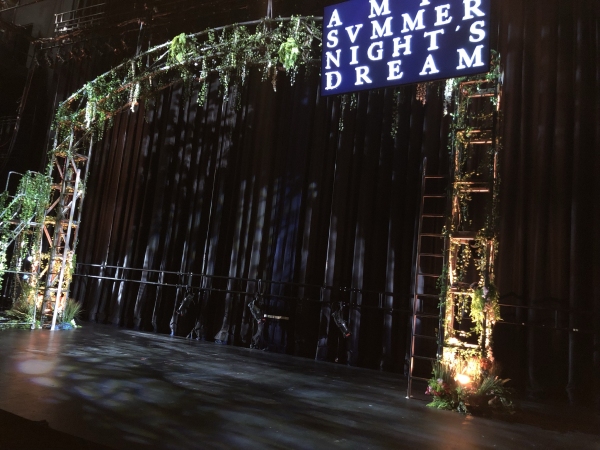 When
the house opened at 7:15, we were led through hallways to the backstage
area where we saw 3 ranks of stadium seating pointed toward the
theatre’s curtain. Two large TV monitors were suspended from above on
either end of the seating and easily visible to the whole audience. They
displayed the words, “A Midsummer Night’s Dream.”
When
the house opened at 7:15, we were led through hallways to the backstage
area where we saw 3 ranks of stadium seating pointed toward the
theatre’s curtain. Two large TV monitors were suspended from above on
either end of the seating and easily visible to the whole audience. They
displayed the words, “A Midsummer Night’s Dream.”
While we were taking our seats, eerie electronic music was playing. And once seated, there was a lot to see as we waited for the play to commence. In front of us was a large metallic arch, perhaps spanning 30 feet and about 12 feet high at its center. It was draped with vines, suggesting that we were in a forest. All around us was theatre tech ─ the trappings of a modern, well-equipped theatre: metallic structures, lights, controls of different kinds, the fly system with its ropes, a catwalk, etc. Then there was the fly tower above us, open for 20 feet or more, giving, along with the large open stage in front of us, a feeling of openness, a sense that we could easily see everything going on.
(Click here to open the program in a new window.)
Before all the audience had even assembled, a couple of men, acting
like stagehands but with subtly painted faces, cavorted around. There
seemed to be no purpose to their antics, except perhaps to quiet the
audience and perhaps put us a little on edge.
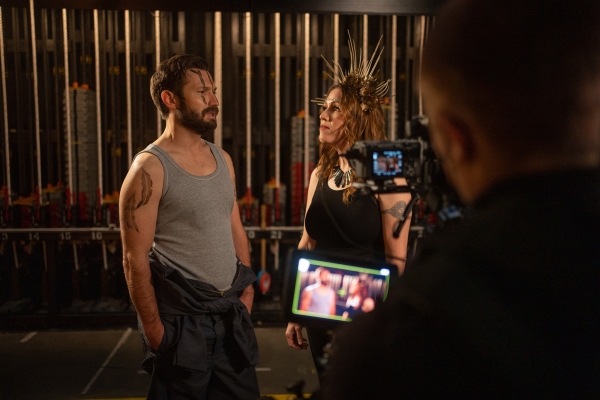
At 7:30, director David Harris came out to greet us. He reiterated the Covid protocols (we were all wearing masks and had proven our vaccination status). Then he explained that tonight’s show was being streamed to audience members at home and that we would be seeing on the screens in front of us what they would be seeing. Our bonus would be that we would be able to see the camera work and most of the action directly. “Most” he explained was because a lot of the action would take place throughout the Harris Center and out of our direct sight. We would be getting the “full experience,” he explained, watching the actors as if they were trapped in this large building. With that introduction, the play began.
My first impression was of the costumes of the actors. They certainly weren’t period costumes, nor were they representative of any culture. Rather they were colorful, often outrageously mismatched, get-ups ─ perhaps casual attire that the actors might have pulled out of their closets (or off the floor) on the way to a meet-up with friends. There were a few exceptions though.
Also notable were the tattoos and make-up. I think most of the performers had tattoos, most perhaps permanent. But I think some temporary tattoos must have been added, particularly to the fairies. And the make-up was strange: lines on faces, particularly the men, perhaps emphasizing the fact that these people were each taking on a fanciful persona.
After the costumes and make-up, the next thing I noticed was the language, pure Shakespeare, and delivered clearly ─ at least for the most part. I should add at this point that the audio transmission was excellent. Each actor was miked, and they were perfectly balanced. My audiologist says that my hearing is a bit less than perfect, yet I caught every word, except some that were delivered with intense excitement.
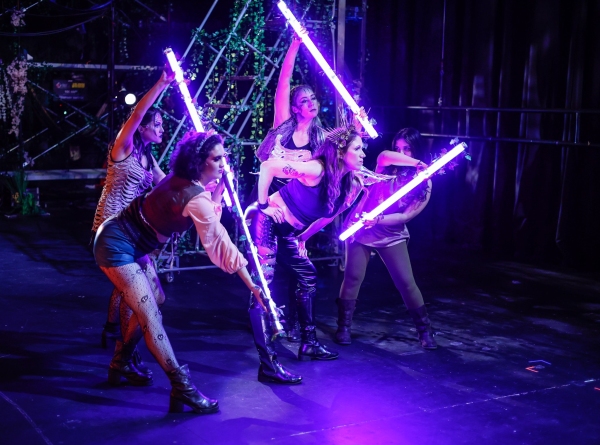 The
action began in front of us, but it soon moved to other parts of Harris
Center: the lobby, the scene shop, office corridors, the grand
staircase, the catwalk above the stage, and even the open theatre behind
the curtain. By the end of the play, I felt that just about every corner
of Harris Center had been used for some scene. Added to that was
performing in and on moveable structures on the stage. I should add that
all of this gave an unheard-of variety of settings for a live
production. One had to marvel at the adventuresomeness of the tactic
─ and the creativity of some of the
props used in these scene settings. There was also the surprise element
of watching characters on the screens as they began a scene, presently
to see them enter and continue the scene in front of us.
The
action began in front of us, but it soon moved to other parts of Harris
Center: the lobby, the scene shop, office corridors, the grand
staircase, the catwalk above the stage, and even the open theatre behind
the curtain. By the end of the play, I felt that just about every corner
of Harris Center had been used for some scene. Added to that was
performing in and on moveable structures on the stage. I should add that
all of this gave an unheard-of variety of settings for a live
production. One had to marvel at the adventuresomeness of the tactic
─ and the creativity of some of the
props used in these scene settings. There was also the surprise element
of watching characters on the screens as they began a scene, presently
to see them enter and continue the scene in front of us.
Then there were the cameras. I think there were 3 camera teams ─ it’s hard to say because I don’t remember seeing them all together. In each team there was the camera operator, and one of these had an impressive rig harnessed to his body, with camera, monitor, etc. Each operator was accompanied by an assistant, though I couldn’t quite tell the assistant’s purpose. These camera people were always on the move, and it was as important for them to hit their next spot as it was for the actors to hit theirs. They moved with the actors, adjusted for close-ups ─ all with as much intense concentration as the performers. No less important was the person in the control room, switching the video feed from one camera to another.
Take a look at the “Creative and Production Team” in the program. You will see titles, the meaning of which you can only guess at. But it is clear that the technical issues in support of the acting required extraordinary skill in planning and managing this streamed production with its many locations.
Did I just say “acting”? I’ve done a disservice by getting to this point without mentioning the acting. In fact, I saw outstanding, inspired acting from just about every member of this cast. They each seemed to bring a bit of their own personalities to their roles, but they fundamentally mastered the characterizations that Shakespeare had given them. I watched them closely ─ their faces and body language. And faces and body language said so much beyond Shakespeare’s words. Each performer brought an intensity to their improbable character, an intensity that made exaggerated emotions somehow believable and certainly entertaining. For the most part, I felt that I was watching professional-quality acting, not amateur acting.
Of course, it was comic acting, and, to me, great comic acting. To
make people laugh with Shakespeare’s period language surely is an art,
requiring an understanding of what is funny in the language or
situation, and then communicating that to an audience with limited
familiarity or recollection of the work being performed. Yet I felt that
communication in the frequent physical comedy that felt uninhibited and
even spontaneous. And along with that physical comedy, it seemed like
the actors often had to say their lines when they were almost out of
breath, as with the elaborately choreographed fight scene among the two
pairs of lovers. But the language itself was delivered in a way that
evoked laughter. I was only sorry there were so few of us in the
audience to offer our laughter to reward the efforts of the players.
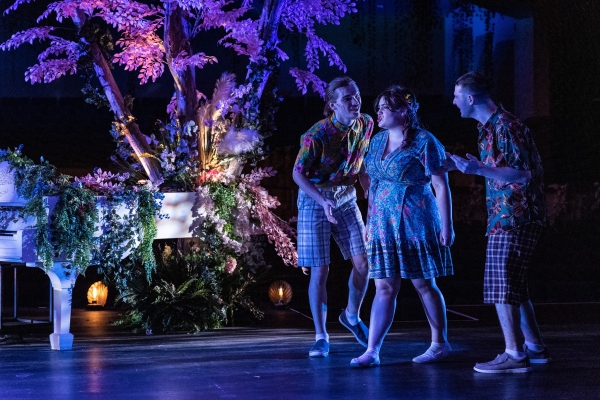
Besides what I’ve pointed out about the different dimensions of comedy, there were the many, many subtle humorous touches. Bottom is confused by his script, so Quince turns it upside down for him. Starveling (I think) wonders whether there will be a full moon at the time of the play, so another character checks her smartphone. So much was happening in this fast-moving performance that I’m sure I missed many of these subtle humorous moments. I’d love to see the play again to catch more of them.
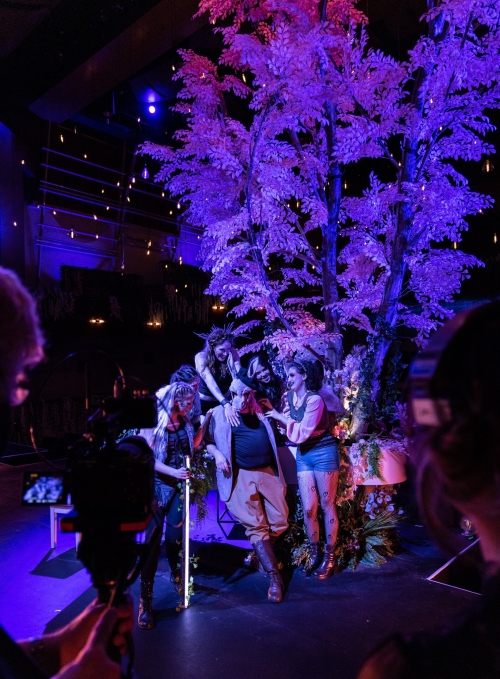 Beyond
the acting, there was music and dancing. Titania, queen of the fairies,
was introduced through a dance routine in which her 4 fairies waved
fluorescent light sticks. Titania herself was the most costumed actor,
with leather pants that must have been obtained from an adult bookstore,
wings and a crown that seemed to emit bolts of light. There was more
choreography, and there was also music, some of it prerecorded, but also
singing accompanied by live piano and guitar players. Enhancing the
action were incidental and prolonged sound effects and musical cues
throughout the show.
Beyond
the acting, there was music and dancing. Titania, queen of the fairies,
was introduced through a dance routine in which her 4 fairies waved
fluorescent light sticks. Titania herself was the most costumed actor,
with leather pants that must have been obtained from an adult bookstore,
wings and a crown that seemed to emit bolts of light. There was more
choreography, and there was also music, some of it prerecorded, but also
singing accompanied by live piano and guitar players. Enhancing the
action were incidental and prolonged sound effects and musical cues
throughout the show.
Perhaps you’re beginning to see how this show was dazzling in so many ways. The key moment, though, happened early in the production after the introduction of Titania. The theatre’s main curtain was raised to reveal the thoroughly decorated 850-seat theatre. First, on the stage there was a white piano laden with decoration (and a pianist), and a 20-foot tree with white leaves that eventually took on different colors. But out in the auditorium there were vines hanging from the balconies, floral effects hanging from the ceiling ─ and eventually a hundred hanging lights, presumably to represent stars in the forest sky at night.
Of all the comic touches, bringing a dog into the final play-within-a-play was a touch of brilliance. The little uncredited dog was well behaved, but the character who had him on a leash (Starveling?) was wearing a sparse grass skirt made of some kind of plastic strands. The dog couldn’t keep from pulling at the strands, and this presumably unscripted development evoked peals of laughter from the audience.
I recall some commentator in the distant past suggesting that the final performance of Pyramus and Thisbe by the “mechanicals” is a let-down after the comic action of the lovers and fairies in the forest. Not so the final “play-within-a-play” that I saw last night. I laughed so hard that my wife had to restrain me. Each of those 6 players, especially Bottom and Flute, wrung every bit of comedy from Shakespeare’s words. It brought me (and I hope everyone else in the audience and watching at home) a bonus episode of soul-cleansing laughter.
Indeed, I will never forget this performance of A Midsummer Night’s Dream by Falcon’s Eye Theatre at Folsom Lake College. I can’t imagine a better, richer, more engaging implementation of Shakespeare’s work that is so suited to the times in which we live. It was a theatrical metaverse. And if that’s not the right word, we need to invent a new one for what I saw last night.
This performance ran November 5 to 21, 2021. Click here for information about future productions of Falcon’s Eye Theatre.
Dick Frantzreb is editor of the Sacramento Choral Calendar, the Placer Performance Calendar, and the Capital Region Performance Gallery. He is also co-founder and past President of the Sacramento Valley Choral Coalition. He has been loving live performances in the greater Sacramento area and writing about them since 2012.